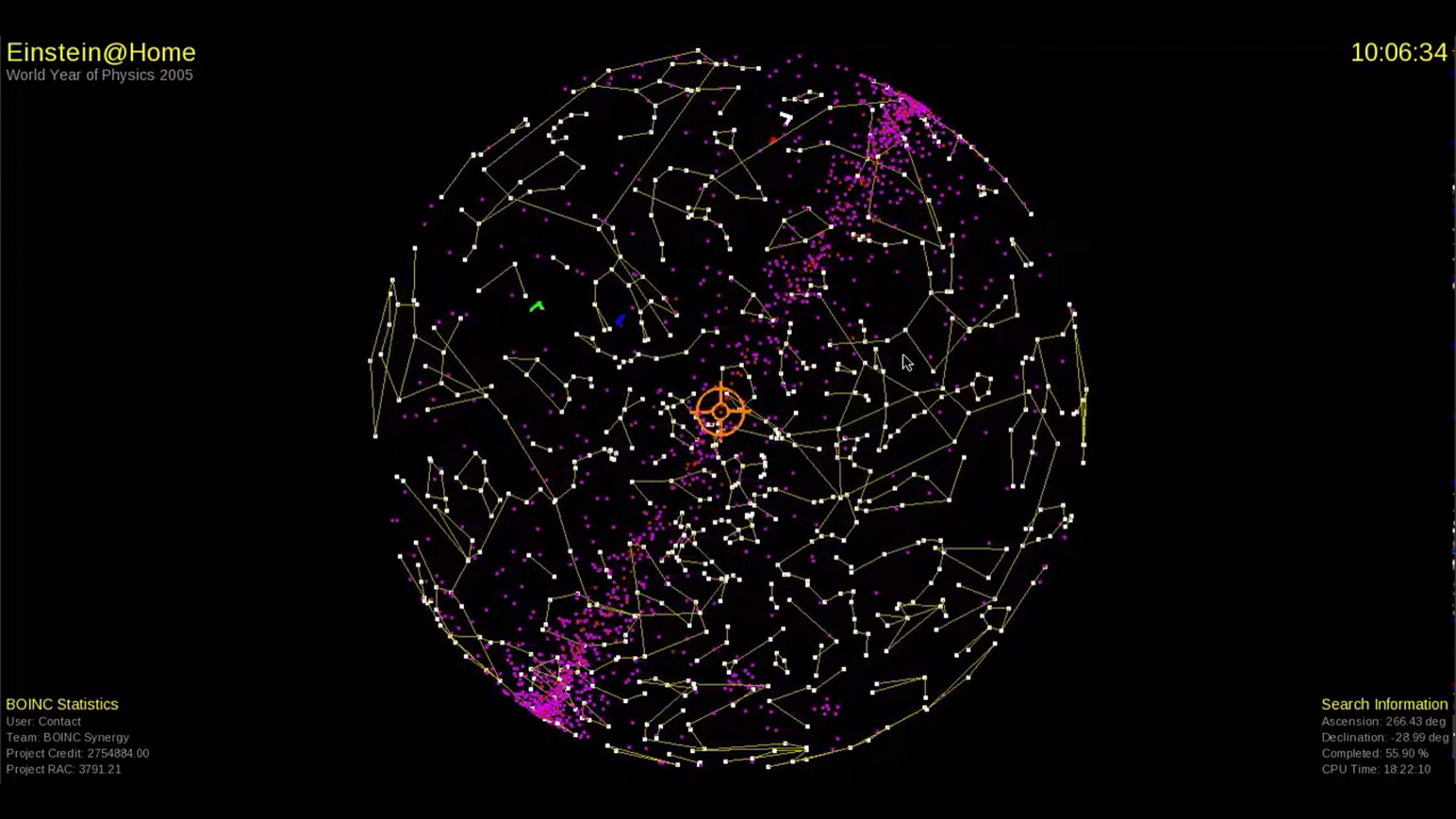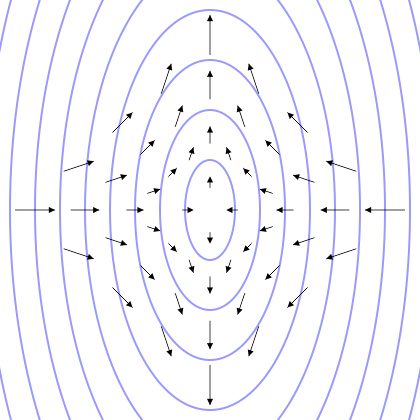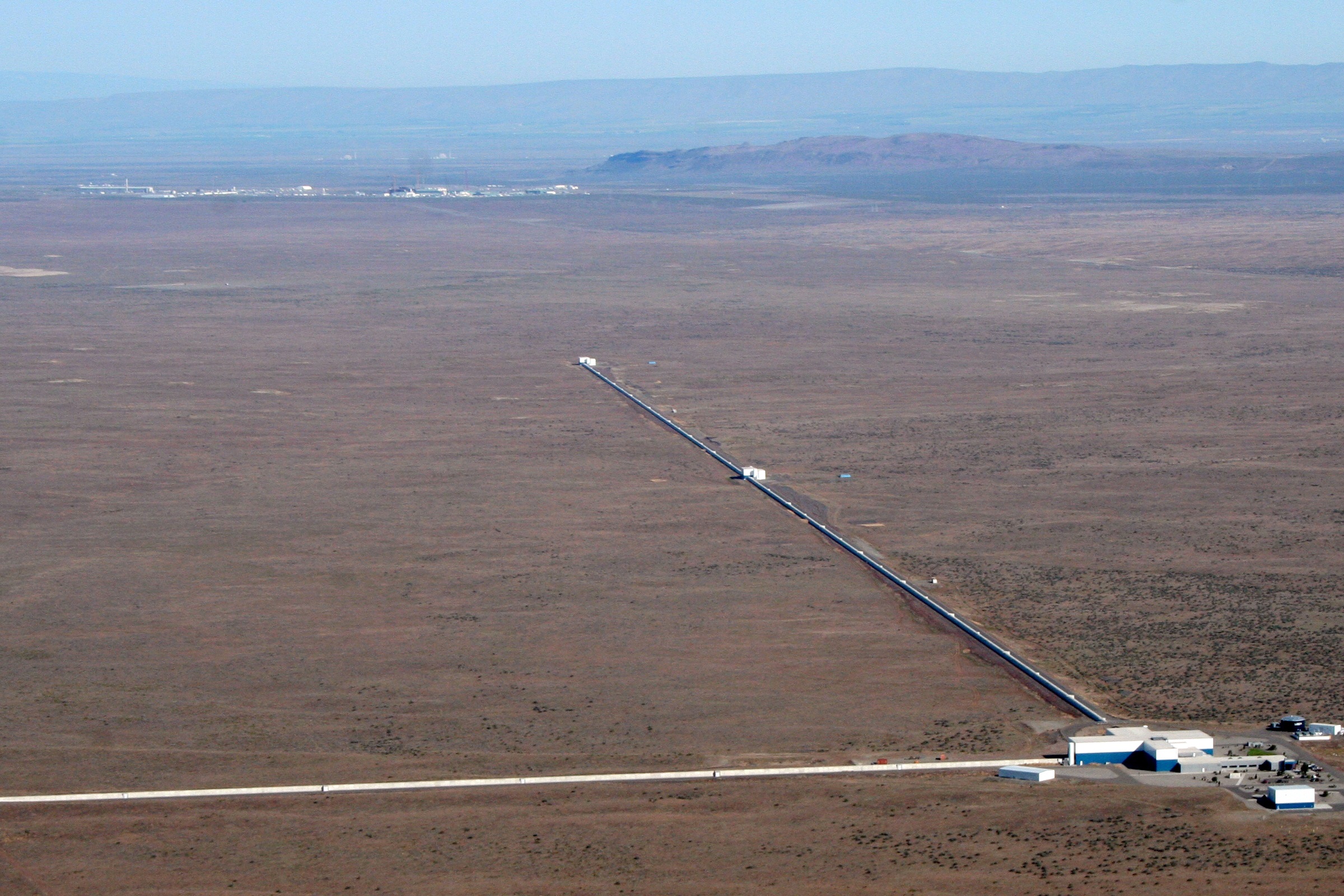|
Einstein@Home
Einstein@Home is a volunteer computing project that searches for signals from spinning neutron stars in data from gravitational-wave detectors, from large radio telescopes, and from a gamma-ray telescope. Neutron stars are detected by their pulsed radio and gamma-ray emission as radio and/or gamma-ray pulsars. They also might be observable as continuous gravitational wave sources if they are rapidly spinning and non-axisymmetrically deformed. The project was officially launched on 19 February 2005 as part of the American Physical Society's contribution to the World Year of Physics 2005 event. Einstein@Home searches data from the LIGO gravitational-wave detectors. The project conducts the most sensitive all-sky searches for continuous gravitational waves. While no such signal has yet been detected, the upper limits set by Einstein@Home analyses provide astrophysical constraints on the Galactic population of spinning neutron stars. Einstein@Home also searches radio telescope data f ... [...More Info...] [...Related Items...] OR: [Wikipedia] [Google] [Baidu] |
Max Planck Institute For Gravitational Physics
The Max Planck Institute for Gravitational Physics (Albert Einstein Institute) is a Max Planck Institute whose research is aimed at investigating Einstein's theory of relativity and beyond: Mathematics, quantum gravity, astrophysical relativity, and gravitational-wave astronomy. The institute was founded in 1995 and is located in the Potsdam Science Park in Golm, Potsdam and in Hannover where it closely collaborates with the Leibniz University Hannover. Both the Potsdam and the Hannover parts of the institute are organized in three research departments and host a number of independent research groups. The institute conducts fundamental research in mathematics, data analysis, astrophysics and theoretical physics as well as research in laser physics, vacuum technology, vibration isolation and classical and quantum optics. When the LIGO Scientific Collaboration announced the first detection of gravitational waves, researchers of the institute were involved in modeling, detecting, ... [...More Info...] [...Related Items...] OR: [Wikipedia] [Google] [Baidu] |
BOINC
The Berkeley Open Infrastructure for Network Computing (BOINC, pronounced – rhymes with "oink") is an open-source middleware system for volunteer computing (a type of distributed computing). Developed originally to support SETI@home, it became the platform for many other applications in areas as diverse as medicine, molecular biology, mathematics, linguistics, climatology, environmental science, and astrophysics, among others. The purpose of BOINC is to enable researchers to utilize processing resources of personal computers and other devices around the world. BOINC development began with a group based at the Space Sciences Laboratory (SSL) at the University of California, Berkeley, and led by David P. Anderson, who also led SETI@home. As a high-performance volunteer computing platform, BOINC brings together 34,236 active participants employing 136,341 active computers (hosts) worldwide, processing daily on average 20.164 PetaFLOPS (it would be the 21st largest processin ... [...More Info...] [...Related Items...] OR: [Wikipedia] [Google] [Baidu] |
Berkeley Open Infrastructure For Network Computing
The Berkeley Open Infrastructure for Network Computing (BOINC, pronounced – rhymes with "oink") is an open-source middleware system for volunteer computing (a type of distributed computing). Developed originally to support SETI@home, it became the platform for many other applications in areas as diverse as medicine, molecular biology, mathematics, linguistics, climatology, environmental science, and astrophysics, among others. The purpose of BOINC is to enable researchers to utilize processing resources of personal computers and other devices around the world. BOINC development began with a group based at the Space Sciences Laboratory (SSL) at the University of California, Berkeley, and led by David P. Anderson, who also led SETI@home. As a high-performance volunteer computing platform, BOINC brings together 34,236 active participants employing 136,341 active computers (hosts) worldwide, processing daily on average 20.164 PetaFLOPS (it would be the 21st largest processing c ... [...More Info...] [...Related Items...] OR: [Wikipedia] [Google] [Baidu] |
Gravitational Wave
Gravitational waves are waves of the intensity of gravity generated by the accelerated masses of an orbital binary system that propagate as waves outward from their source at the speed of light. They were first proposed by Oliver Heaviside in 1893 and then later by Henri Poincaré in 1905 as waves similar to electromagnetic waves but the gravitational equivalent. Gravitational waves were later predicted in 1916 by Albert Einstein on the basis of his general theory of relativity as ripples in spacetime. Later he refused to accept gravitational waves. Gravitational waves transport energy as gravitational radiation, a form of radiant energy similar to electromagnetic radiation. Newton's law of universal gravitation, part of classical mechanics, does not provide for their existence, since that law is predicated on the assumption that physical interactions propagate instantaneously (at infinite speed)showing one of the ways the methods of Newtonian physics are unable to explain ph ... [...More Info...] [...Related Items...] OR: [Wikipedia] [Google] [Baidu] |
PSR J2007+2722
PSR J2007+2722 is a 40.8-hertz isolated pulsar in the Vulpecula constellation, 5.3 kpc (17,000 ly) distant in the plane of the Galaxy, and is most likely a disrupted recycled pulsar (DRP). J2007+2722 was found on data taken by the Arecibo radio telescope in February 2007, and analyzed by volunteers Chris and Helen Colvin (Ames, Iowa, USA) and Daniel Gebhardt (Universität Mainz, Musikinformatik, Germany) via the distributed computing project Einstein@Home Einstein@Home is a volunteer computing project that searches for signals from spinning neutron stars in data from gravitational-wave detectors, from large radio telescopes, and from a gamma-ray telescope. Neutron stars are detected by their pulse .... References ;Notes ;Sources * * External links * * Pulsars Vulpecula {{var-star-stub ... [...More Info...] [...Related Items...] OR: [Wikipedia] [Google] [Baidu] |
Laser Interferometer Gravitational-Wave Observatory
The Laser Interferometer Gravitational-Wave Observatory (LIGO) is a large-scale physics experiment and observatory designed to detect cosmic gravitational waves and to develop gravitational-wave observations as an astronomical tool. Two large observatories were built in the United States with the aim of detecting gravitational waves by laser interferometry. These observatories use mirrors spaced four kilometers apart which are capable of detecting a change of less than one ten-thousandth the charge diameter of a proton. (that is, to Proxima Centauri at ). The initial LIGO observatories were funded by the United States National Science Foundation (NSF) and were conceived, built and are operated by Caltech and MIT. They collected data from 2002 to 2010 but no gravitational waves were detected. The Advanced LIGO Project to enhance the original LIGO detectors began in 2008 and continues to be supported by the NSF, with important contributions from the United Kingdom's Science ... [...More Info...] [...Related Items...] OR: [Wikipedia] [Google] [Baidu] |
LIGO
The Laser Interferometer Gravitational-Wave Observatory (LIGO) is a large-scale physics experiment and observatory designed to detect cosmic gravitational waves and to develop gravitational-wave observations as an astronomical tool. Two large observatories were built in the United States with the aim of detecting gravitational waves by laser interferometry. These observatories use mirrors spaced four kilometers apart which are capable of detecting a change of less than one ten-thousandth the charge diameter of a proton. (that is, to Proxima Centauri at ). The initial LIGO observatories were funded by the United States National Science Foundation (NSF) and were conceived, built and are operated by Caltech and MIT. They collected data from 2002 to 2010 but no gravitational waves were detected. The Advanced LIGO Project to enhance the original LIGO detectors began in 2008 and continues to be supported by the NSF, with important contributions from the United Kingdom's Science ... [...More Info...] [...Related Items...] OR: [Wikipedia] [Google] [Baidu] |
Pulsars
A pulsar (from ''pulsating radio source'') is a highly magnetized rotating neutron star that emits beams of electromagnetic radiation out of its magnetic poles. This radiation can be observed only when a beam of emission is pointing toward Earth (similar to the way a lighthouse can be seen only when the light is pointed in the direction of an observer), and is responsible for the pulsed appearance of emission. Neutron stars are very dense and have short, regular rotational periods. This produces a very precise interval between pulses that ranges from milliseconds to seconds for an individual pulsar. Pulsars are one of the candidates for the source of ultra-high-energy cosmic rays. (See also centrifugal mechanism of acceleration.) The periods of pulsars make them very useful tools for astronomers. Observations of a pulsar in a binary neutron star system were used to indirectly confirm the existence of gravitational radiation. The first extrasolar planets were discovered aroun ... [...More Info...] [...Related Items...] OR: [Wikipedia] [Google] [Baidu] |
FLOPS
In computing, floating point operations per second (FLOPS, flops or flop/s) is a measure of computer performance, useful in fields of scientific computations that require floating-point calculations. For such cases, it is a more accurate measure than measuring instructions per second. Floating-point arithmetic Floating-point arithmetic is needed for very large or very small real numbers, or computations that require a large dynamic range. Floating-point representation is similar to scientific notation, except everything is carried out in base two, rather than base ten. The encoding scheme stores the sign, the exponent (in base two for Cray and VAX, base two or ten for IEEE floating point formats, and base 16 for IBM Floating Point Architecture) and the significand (number after the radix point). While several similar formats are in use, the most common is ANSI/IEEE Std. 754-1985. This standard defines the format for 32-bit numbers called ''single precision'', as well as 6 ... [...More Info...] [...Related Items...] OR: [Wikipedia] [Google] [Baidu] |
Bruce Allen (physicist)
Bruce Allen (born May 11, 1959) is an American physicist and director of the Max Planck Institute for Gravitational Physics in Hannover Germany and leader of the Einstein@Home project for the LIGO Scientific Collaboration. He is also a physics professor at the University of Wisconsin–Milwaukee and the initiator / project leader of smartmontools hard disk utility. He has done research work on models of the very early universe (inflationary cosmology, cosmic strings). Allen currently leads a research group working on the detection of gravitational waves. In this role, he was one of the first scientists to become aware of the initial detection of GW150914 at LIGO, in September 2015. Allen's research work has been funded by the US National Science Foundation since 1987. Education and positions *1976 Graduated from Wayland High School, Wayland, Massachusetts, USA. (Allen belonged to the class of 1977, but graduated a year early with the class of 1976). *1980 B.S. ... [...More Info...] [...Related Items...] OR: [Wikipedia] [Google] [Baidu] |
University Of Wisconsin–Milwaukee
The University of Wisconsin–Milwaukee (UW–Milwaukee, UWM, or Milwaukee) is a public urban research university in Milwaukee, Wisconsin. It is the largest university in the Milwaukee metropolitan area and a member of the University of Wisconsin System. It is also one of the two doctoral degree-granting public universities and the second largest university in Wisconsin. The university consists of 14 schools and colleges, including the only graduate school of freshwater science in the U.S., the first CEPH accredited dedicated school of public health in Wisconsin, and the state's only school of architecture. As of the 2015–2016 school year, the University of Wisconsin–Milwaukee had an enrollment of 27,156, with 1,604 faculty members, offering 191 degree programs, including 94 bachelor's, 64 master's and 33 doctorate degrees. The university is classified among "R1: Doctoral Universities – Highest research activity". In 2018, the university had a research expenditure of ... [...More Info...] [...Related Items...] OR: [Wikipedia] [Google] [Baidu] |
American Physical Society
The American Physical Society (APS) is a not-for-profit membership organization of professionals in physics and related disciplines, comprising nearly fifty divisions, sections, and other units. Its mission is the advancement and diffusion of knowledge of physics. The society publishes more than a dozen scientific journals, including the prestigious '' Physical Review'' and ''Physical Review Letters'', and organizes more than twenty science meetings each year. APS is a member society of the American Institute of Physics. Since January 2021 the organization has been led by chief executive officer Jonathan Bagger. History The American Physical Society was founded on May 20, 1899, when thirty-six physicists gathered at Columbia University for that purpose. They proclaimed the mission of the new Society to be "to advance and diffuse the knowledge of physics", and in one way or another the APS has been at that task ever since. In the early years, virtually the sole activity of the AP ... [...More Info...] [...Related Items...] OR: [Wikipedia] [Google] [Baidu] |







